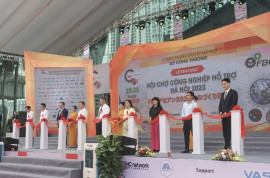This article, "10 principles for improving production cost," continues the research findings and experience of P&Q Solutions in consulting, training, and the processes that guide our improvement, lean transformation, and capacity building programs from the previous article.
This article introduces Principles 6 to 10.
6) Driven by Principles and Supported by Lean Production Methods
While financial flows reflect value flows, cost structures reflect product and production process structures, financial efficiency is related to work efficiency, and most costs are related to "waste," Lean manufacturing can be used as a framework to guide production cost improvement.
Lean Manufacturing's 5 principles of Value, Value Flow, Continuous Flow, Pull Mechanism and Continuous Improvement serve as a long-term guide to the cost improvement program from the customer's perspective. on value to eliminate non-value-added factors, eliminate waiting and overproduction. Financially, these principles help businesses have clear and feasible directions in terms of optimizing investments, reducing capital needs and costs, improving cash flow, minimizing risks and liquidity. accounts, and optimize cost norms.
In terms of implementation, Lean Manufacturing's tools and practices provide solutions to realize the orientations and ideas of improving production costs comprehensively, from strategic implementation with Hoshin Kanri to optimization. value flow according to VSM and stage with Standard Work; from product quality with Quality Function Deployment (QFD) to production planning with Standardized Vessel (Hejunka) and field management with 5S; from improving equipment performance with Total Productive Maintenance (TPM) to worker skills with On-the-job Training (TWI); from executive roles with Management's Standard Work to visualizing results with Visual Management, and solving problems with 5 Whys, TBP (Toyota's problem-solving approach).
7) Connect Finance with Operations based on Lean Accounting
In the manufacturing sector, QCD (Quality, Cost and Delivery) goals have always been at the heart of management and improvement. With the current level of maturity in most manufacturing enterprises, product quality management is no longer an integral function of the quality management department based on frequent inspection activities and periodic reports. Instead, in the spirit of quality management at the root and bottom, quality control and improvement has been designed to be integrated into each stage with the increasing involvement and role of the production department. Similar transformation has also occurred in production planning management, enterprises have focused on root and root management with cycle time and proactive short cycle management by production without delay. do not rely solely on aggregated data and reports from the production planning department.
To manage and improve production costs effectively, the same approach should be applied to ensure that production costs are controlled at the source and at the source with the participation and greater role of the production department. output – directly using resources and creating value. Lean Accounting is an approach to realize this orientation.
Lean Accounting is a management accounting system that reflects, adapts and promotes Lean transformation in the enterprise through value-driven accounting throughout the product lifecycle. Lean accounting and its financial metrics are used to run operations, drive focus, and lead a program of periodic improvement. In Lean Accounting practice, tracking and analysis of revenue and expense results is done at the production line level up to the value stream and the business helps in decision making. Management is introduced early, at the root and at the root to ensure the ability to effectively pursue financial indicators at production levels. As a result, efficiency and finance and improvement of production costs are realized and improved.
8) Drive from the field through the Waste – Loss – Finance chain
The financial performance of the business reflects efficiency and waste at the operational level, which is measured and managed through operational management metrics before being converted into financial metrics. main.
Therefore, the process of realizing production cost improvement is the process from identifying and eliminating waste, quantifying the identified and eliminated waste values into operational management indicators, and finally together convert operational management metrics into financial metrics. In the opposite direction, when planning activities to improve production costs, the orientations are started from financial targets, deployed to operational management indicators and realized through identification and elimination of waste. fee. The example in the figure below illustrates the relationship between wasted labor time due to a low pass balance and the ratio of personnel loss, financial loss, and profit.
Thus, understanding and managing the relationship between waste - loss - finance, on the one hand, helps the improvement activities of the enterprise to gain motivation for implementers and commitment from all levels of management. due to its ability to link to quantifiable results of operational loss and financial performance. In turn, this connection also provides a firm with a solid, workable approach and framework for realizing plans to improve financial performance – part of periodic planning at the enterprise and corporate level. part.
9) Promote & Balance stakeholder interests
A comprehensive and sustainable cost improvement program should promote and balance the interests of interested parties, namely employees, management, business owners, customers and suppliers.
Internally, the ability to continuously improve production costs primarily helps businesses improve operational efficiency and competitive position, thereby improving the income and welfare of direct workers and management personnel. physical. Besides, the production cost improvement program is also a good opportunity to develop the capacity and add value of the members of the organization. This helps businesses improve their ability to attract, retain and mobilize the participation of their staff.
At the supply chain level, the involvement and cooperation of customers and suppliers ensures that you can effectively implement cost improvement initiatives throughout the supply chain such as product design. , technical standards, change management, pull-and-reduce mechanisms, normalization…
10) Personal Development & Team Capability Release
Enterprises cannot achieve production cost improvement results by repeating the previous way of working. The Tower of Change model in the figure below illustrates the extent to which changes to improve production costs can be implemented continuously, extensively, and sustainably.
Simply put, production cost improvement results are realized through the implementation of new practices, such as line balancing, continuous flow, fast switching, total productivity maintenance, purchasing according to the principles of just-in-time production and pull mechanisms, etc. These practices help identify and eliminate waste (groups) of waste, specific losses in operations, and develop the capabilities of employees. , the team in applying tools and processes to improve production costs.
In addition, the pursuit of Lean Manufacturing principles, aligning cost improvement with value flow and product lifecycle, focus on waste and non-value-added activities, cross-functional mobilization and cross-functional implementation, ... provides businesses with new approach frameworks in which cost improvement practices are systematically and effectively planned and implemented. Pursuing the Plan – Do – Check – Adjust cycle with these approaches helps businesses continuously expand their understanding of the guiding principles, the interrelationships between factors, functions, divisions and levels in their system. Through that, enterprises develop their capacity as a team to effectively solve the challenges of improving production costs.
Finally, with the recognition of production cost improvement as a long-term strategy associated with the development of enterprise competitiveness, strengthening supply chain linkages and capacity development, enterprises form a Clear awareness and direction harmonize with and create effective leverage in fostering mutually beneficial relationships. This awareness and orientation is the foundation for pursuing approaches and implementing practices and tools to improve production costs.
Author: Pham Minh Thang, Director of P&Q Solutions

















